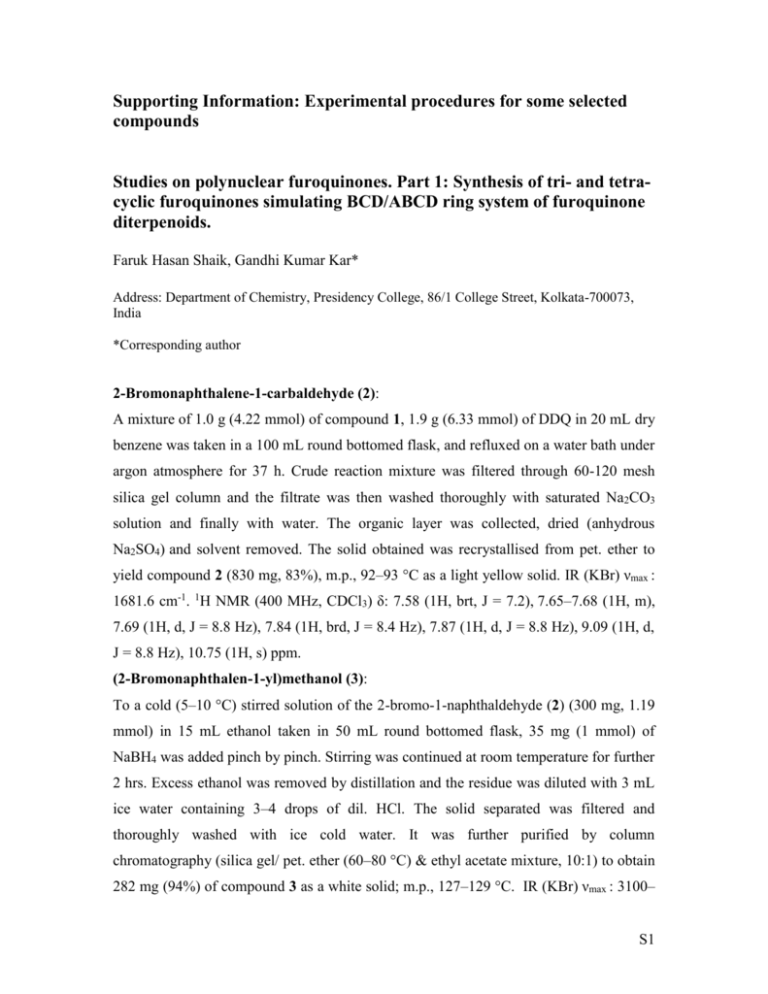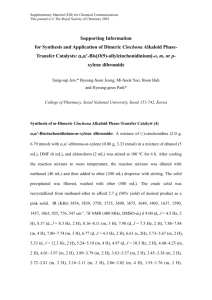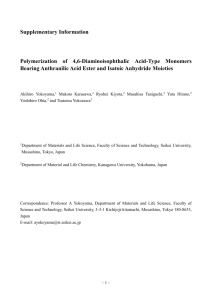hcl chromatography
advertisement

Supporting Information: Experimental procedures for some selected compounds Studies on polynuclear furoquinones. Part 1: Synthesis of tri- and tetracyclic furoquinones simulating BCD/ABCD ring system of furoquinone diterpenoids. Faruk Hasan Shaik, Gandhi Kumar Kar* Address: Department of Chemistry, Presidency College, 86/1 College Street, Kolkata-700073, India *Corresponding author 2-Bromonaphthalene-1-carbaldehyde (2): A mixture of 1.0 g (4.22 mmol) of compound 1, 1.9 g (6.33 mmol) of DDQ in 20 mL dry benzene was taken in a 100 mL round bottomed flask, and refluxed on a water bath under argon atmosphere for 37 h. Crude reaction mixture was filtered through 60-120 mesh silica gel column and the filtrate was then washed thoroughly with saturated Na2CO3 solution and finally with water. The organic layer was collected, dried (anhydrous Na2SO4) and solvent removed. The solid obtained was recrystallised from pet. ether to yield compound 2 (830 mg, 83%), m.p., 92–93 °C as a light yellow solid. IR (KBr) νmax : 1681.6 cm-1. 1H NMR (400 MHz, CDCl3) δ: 7.58 (1H, brt, J = 7.2), 7.65–7.68 (1H, m), 7.69 (1H, d, J = 8.8 Hz), 7.84 (1H, brd, J = 8.4 Hz), 7.87 (1H, d, J = 8.8 Hz), 9.09 (1H, d, J = 8.8 Hz), 10.75 (1H, s) ppm. (2-Bromonaphthalen-1-yl)methanol (3): To a cold (5–10 °C) stirred solution of the 2-bromo-1-naphthaldehyde (2) (300 mg, 1.19 mmol) in 15 mL ethanol taken in 50 mL round bottomed flask, 35 mg (1 mmol) of NaBH4 was added pinch by pinch. Stirring was continued at room temperature for further 2 hrs. Excess ethanol was removed by distillation and the residue was diluted with 3 mL ice water containing 3–4 drops of dil. HCl. The solid separated was filtered and thoroughly washed with ice cold water. It was further purified by column chromatography (silica gel/ pet. ether (60–80 °C) & ethyl acetate mixture, 10:1) to obtain 282 mg (94%) of compound 3 as a white solid; m.p., 127–129 °C. IR (KBr) νmax : 3100– S1 3345 (br) cm-1; 1H NMR (400 MHz, CDCl3) δ: 1.19 (1H, t, J = 6.1 Hz), 5.30 (2H, d, J = 6.1 Hz), 7.52 (1H, brt, J = 7.2 Hz), 7.59 (1H, brt, J = 7.2 Hz), 7.61 (1H, d, J = 8.8 Hz), 7.67 (1H, d, J = 8.8 Hz), 7.83 (1H, d, J = 8 Hz), 8.24 (1H, d, J = 8.4 Hz) ppm. 2-Bromo-1-bromomethylnaphthalene (4): A mixture of compound 3 (300 mg, 1.27 mmol), PBr3 (160 mg, 0.59 mmol) and 5 mL CCl4 was stirred at 60 °C for 1 hr protecting from moisture. It was then cooled to room temperature, poured into crushed ice and extracted with CHCl3 (2x 10 mL). The CHCl3 layer was washed with saturated NaHCO3 solution followed by water. Organic layer was separated, dried over anhyd.Na2SO4 and solvent removed to furnish the bromide 4 as a faint yellow solid which was purified by column chromatography [silica gel/10:1 pet. ether (60–80 °C)-ethyl acetate]. Yield, 252 mg (82%); m.p., 97–98 °C. 1H NMR (400MHz, CDCl3) δ: 5.13 (2H, s), 7.54 (1H, brt, J = 7.2 Hz), 7.61 (1H, d, J = 8.8 Hz), 7.66 (1H. brt, J = 7.2 Hz), 7.68 (1H, d, J = 8.8 Hz), 7.84 (1H, d, J = 8.0 Hz), 8.11 (1H, d, J = 8.4 Hz) ppm; 13C NMR (75 MHz, CDCl3) δ: 30.27, 123.74, 126.47, 127.71, 128.85, 130.26, 130.55, 132.07, 132.15, 132.80 ppm.(peak due to one quaternary carbon was not observed in this NMR. Possibly it is merged with some other signal); HRMS (ESI, 70 eV): m/z = 300.9041 [M++H] (calculated mass for C11H8Br2: 300.9045 [M++H]). (2-Bromo-naphthalen-1-yl)acetonitrile (5): In a 50 mL round bottomed flask fitted with anhydrous CaCl2 guard tube, 270 mg (0.9 mmol) of bromide 4 and 2 mL dry DMF was taken. To this 120 mg (1.85 mmol) of potassium cyanide was added and stirred at room temperature. for overnight and then 1 h at 50°C. The reaction mixture was then poured into 5 mL ice water and extracted with ether. Ether part was washed thoroughly with ice-cold brine solution and finally once with ice cold H2O. Organic part was collected; dried (anhydrous Na2SO4) and removal of solvent afforded the crude cyanide derivative 5. It was purified by column chromatography [silica gel/ pet. ether (60–80 °C) and EtOAc, 20:1]. Yield, 150 mg (68%); white solid; m.p., 127–129 °C. IR (KBr) νmax: 2245.7 cm-1; 1H NMR (400 MHz, CDCl3) δ: 4.34 (2H, s), 7.57 (1H, m), 7.64–7.67 (2H, m), 7.72 (1H, d, J = 8.8 Hz), 7.87 (1H, d, J = 7.9 Hz), 7.8 (1H, d, J = 8.7 Hz) ppm. S2 (2-Bromo-naphthalen-1-yl)acetic acid (6): In a 25 mL round bottomed flask attached with a reflux condenser, 200 mg (0.81 mmol) of compound 5, 3 mL 20% KOH and 10 mL methanol was taken and refluxed at 100 °C for 23 h. Excess methanol was removed by distillation and the residue was diluted with ice-water and neutral part was extracted with ether. Aqueous part was acidified with 1:1 HCl under ice cold condition. Solid appeared was filtered through suction. The residue was again dissolved in NaHCO3 solution and filtered. Filtrate was acidified with conc. HCl in ice cold condition and solid separated was filtered. It was recrystallised from pet. ether and ethyl acetate mixture. Yield, 160 mg (74%); white solid, m.p., 187–188 °C. IR (KBr) νmax: 1693.3 cm-1. (2-Bromo-naphthalen-1-yl)acetic acid methyl ester (7): 160 mg (0.6 mmol) of compound 6 was added pinch by pinch, to an ether solution of diazomethane (generated from 200 mg nitrosomethylurea at 0 °C. Removal of solvent afforded the ester 7 which was recrystallised from pet. ether (60–80 °C) to produce pure 7 as colorless solid. Yield 160 mg (95%); m.p., 96–97 °C. IR (KBr) νmax: 1732.7 cm-1 ; 1 H NMR (500 MHz, CDCl3) δ: 3.70 (3H, s), 4.36 (2H, s), 7.51 (1H, t, J = 7.3 Hz), 7.56 (1H, t, J = 7.2 Hz), 7.66 (2H, brs), 7.83 (1H, d, J = 7.8 Hz), 7.94 (1H, d, J = 8.4 Hz) ppm. [(2-Furan)-2-yl-naphthalen-1-yl]acetonitrile (10): A mixture of compound 5 (150 mg, 0.61 mmol), furan-2-boronic acid (82 mg, 0.73 mmol), Et3N (0.5 mL, 3.6 mmol) and DMF (1.5 mL) was degassed by argon for 30 min and then to it the catalyst, Pd(PPh3)4 (15mg, ~2 mol %) was added. The mixture was then heated with stirring at 110 °C under argon atmosphere for 37 hrs. After cooling to room temperature it was poured in cold water and extracted with ether. After usual work up followed by purification with column chromatography (silica gel/ pet. ether–ethyl acetate, 10:1) afforded 95 mg (66%) of 10 as a light yellow solid (m.p.,103–104 °C). IR(KBr) νmax 2247.6 cm-1 ; 1H NMR (500MHz, CDCl3) δ: 4.30 (2H, s), 6.60 (1H, d, J = 1.5 Hz) , 6.76 (1H, d, J = 2.8 Hz), 7.56 (1H, t, J = 7.4 Hz), 7.66 (2H, m), 7.70 (1H, d, J = 8.6 Hz), 7.88 (2H, m), 8.07 (1H, d, J = 8.5 Hz) ppm; 13C NMR (125 MHz, CDCl3) δ: 18.63, 110.48, 111.79, 118.14, 122.37, 123.41, 125.96, 126.58, 127.77, 128.88, 129.19, 131.87, 133.15, 143.39, 152.57 ppm ( signal due to one carbon was not observed , possibly it is S3 merged with any other signal); HRMS (ESI, 70 eV): m/z = 256.0736 [M++Na] (calculated mass for C16H11ONNa: 256.0739 [M++Na]). Hydrolysis of the nitrile 10 to prepare the acid 9: 90 mg (0.39 mmol) of the nitrile 10 on hydrolysis with KOH ( 20% solution, 1 mL) and 3–4 mL of ethanol under reflux at 100 °C for 45 h afforded, after usual work up, the acid 9 ( 43 mg, 48%, m.p., 196–198 °C ) and the amide 11 ( 20 mg, 20%) as neutral part. Compound 11: white solid, m.p., 237–238 °C. IR (KBr) νmax 1654.6, 3191.6, 3378.6 cm; H NMR (500 MHz, CDCl3)δ: 4.25 (2H,s), 5.36 (1H, brs), 5.56 (1H, brs), 6.58 (1H, 1 1 brs), 6.68 (1H, brs), 7.54 (1H, t, J = 7.5 Hz), 7.60 ( 1H, brt, J = 7.5 Hz), 7.61 (1H, brs), 7.74 (1H, d, J = 8.5 Hz), 7.86 (1H, brd, J = 7.8 Hz), 7.87 (1H, brd, J = 7.8 Hz), 8.13 (1H, brd, J = 8.5 Hz) ppm. Methyl [2-(2-furyl)phenyl]acetate (15): A mixture of methyl 2-bromophenylacetate (14) (690 mg, 3.01 mmol), furan-2-boronic acid (403 mg, 3.62 mmol), Et3N (0.9 mL, 6.5 mmol) and DMF (2 mL) taken in a two necked flask, was degasified by nitrogen for 30 min. Then Pd(PPh3)4 catalyst (70 mg, ~2 mol%,) was added to the reaction mixture under nitrogen atmosphere. Then reaction mixture was heated with stirring at 110 °C under nitrogen atmosphere for 7 h (completion of the reaction was monitored by TLC). The mixture was then cooled and poured into ice water (~20 mL) with stirring and extracted with ether (3 x 20 mL). Ether part was washed successively with 5% brine, saturated NaHCO3 solution and finally thoroughly with water and dried (anhydrous Na2SO4). Removal of the solvent afforded the crude product which was purified by column chromatography (silica gel/ pet. ether (60–80 °C)–ethyl acetate mixture, 10:1) to obtain compound 15 as a pale yellow oil (545 mg, 84%). IR (KBr) νmax: 1729.8 cm-1. 1H NMR (400 MHz, CDCl3) δ 3.67 (3H, s), 3.87 (2H, s), 6.47 (1H, dd, J = 3 Hz & 1.8 Hz), 6.56 (1H, d, J = 3 Hz), 7.27–7.34 (3H, m), 7.48 (1H, d, J = 1.3 Hz), 7.61 (1H, d, J = 7.4 Hz) ppm. [2-(2-furyl)phenyl]acetic acid (16): To a solution of 15 (250 mg, 1.16 mmol) in EtOH (3.5 mL), 1 ml 20% aqueous solution of KOH was added. The mixture was refluxed on a water bath for 9 h. The excess EtOH was then removed and the residue was diluted with 5 mL of ice water and extracted with ether to remove the neutral part if any. The aqueous alkaline part was cooled in ice-salt S4 mixture and acidified with 5N HCl. The white ppt. appeared was filtered under suction, washed thoroughly with ice-water and dried. Yield, 182 mg (90%); m.p., 128–129 °C. IR(KBr) νmax: 1692.2 cm-1. HRMS (ESI, 70 eV): m/z = 225.0524 [M++Na] (calculated mass for C12H10O3Na: 225.0528 [M++Na]). Naphtho[1,2-b]furan-4-ol (17): In a 5 ml round bottomed flask, the acid 16 (200 mg, 0.99 mmol) was taken and to it 2.5 mL trifluoroacetic anhydride and 0.5 mL of trifluoroacetic acid was added. The mixture was stirred at room temperature for overnight protecting from moisture. The reaction mixture was then poured into ice cold saturated NaHCO3 solution with stirring and extracted with dichloromethane (3x10 mL). DCM layer was washed successively with NaHCO3 solution and water and then dried over anhydrous Na2SO4. Solvent was distilled out and the crude product thus obtained was purified by column chromatography (silica gel/ benzene) to furnish compound 17 as a faint brownish solid. . Yield, 100 mg (54%); m.p., 109–111 °C. IR(KBr) νmax 3267 cm-1; 1H NMR (400 MHz, CDCl3) δ: 5.32 (1H, s), 6.93 (1H, s), 6.99 (1H, d, J = 2 Hz), 7.41–7.46(2H, m), 7.74 (1H, d, J = 2 Hz), 7.73–7.77 (1H, m), 8.19–8.23 (1H, m) ppm; 13 C NMR (125 MHz, CDCl3) δ: 103.85, 104.62, 116.05, 117.78, 120.15, 123.93, 125.81, 126.68, 132.39, 143.78, 147.98, 152.19 ppm; HRMS (ESI, 70 eV): m/z = 185.0595 [M++H] (calculated mass for C12H9O2: 185.0597 [M++H]). S5








